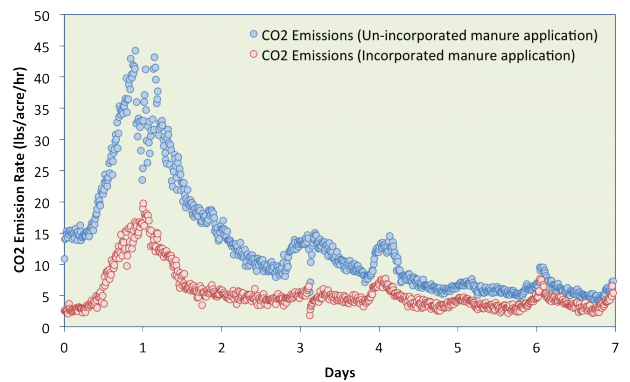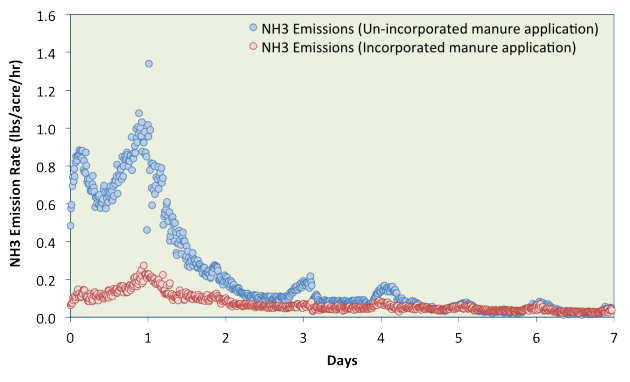![]() Waste to Worth home | More proceedings….
Waste to Worth home | More proceedings….
*Abstract
Gas emissions from animal feeding operations (AFOs) create adverse impacts ranging from short-term local effects on air quality, particularly odor, to the long-term effects from greenhouse gas generation. Best management practices (BMPs) have been designed and implemented to mitigate gas emissions from farm operations. Our study investigates emission control strategies widely used in AFOs including manure management and land application. The primary objectives were to evaluate the efficiency and identify improvement of the currently available BMPs. We simulated and monitored gaseous emissions from a range of manure application and incorporation methods. The gaseous emissions were monitored using the closed dynamic chamber (CDC) method with a Fourier Transformed Infrared (FTIR) spectroscopy gas analyzer, which is capable of monitoring 15 pre-programmed gases simultaneously including typical gaseous compounds and greenhouse gases emitted from manure sources; namely, ammonia, carbon dioxide, methane, nitrous oxide, oxides of nitrogen, and volatile organic compounds. In this presentation, we will discuss the efficiency of the current manure management BMPs to reduce air emissions from dairy operations, based on the gaseous emission monitoring during the course of our experiment. Results from our study should enhance development and implementation of more flexible and more efficient air quality management approaches for dairy operations.
Why Study Gas Emissions from Manure Application Sites?
Evaluate gaseous emissions from manure application. Identify ways to improve manure management and land application BMPs.
What Did We Do?
Manure application and incorporation methods were simulated and evaluated in a greenhouse setting. Scraped dairy manure was applied at a rate of 50 tons/acre to a Millville silt loam soil. Incorporation versus no incorporation was compared. Gaseous emissions were monitored using a closed dynamic chamber with a Fourier Transformed Infrared (FTIR) spectroscopy gas analyzer, which is capable of monitoring 15-pre-programmed gases simultaneously including typical gaseous compounds and greenhouse gases emitted from manure sources; namely, ammonia, carbon dioxide, methane, nitrous oxide, oxides of nitrogen, and volatile organic compounds. On Day 3, after emissions had subsided, the soil surface was rewetted. Emissions were monitored for 7 days.
What Have We Learned?
Emission rates for CO2 and NH3 peaked after 24 hours, with the majority of emissions occurring within the first 2 days. Rewetting had limited impact. Based on this data, it appears that rapid incorporation is needed to have a meaningful impact on reducing gaseous emissions.

Carbon Dioxide Emissions |

Ammonia Emissions |
Future Plans
Examine gaseous emissions from a range of manure application and incorporation methods in a field setting. The gaseous emissions will be monitored using the closed dynamic chamber method with a Fourier Transformed Infrared (FTiR) spectroscopy gas analyzer.
Authors
Rhonda Miller, Ph.D.; Agricultural Systems Technology and Education Dept.; Utah State University rhonda.miller@usu.edu
Pakorn Sutitarnnontr; Environmental Soil Physics Group; Utah State University
Enzhu Hu; Environmental Soil Physics Group; Utah State University
Markus Tuller, Ph.D.; Soil, Water, and Environmental Science Dept.; University of Arizona
Jim Walworth, Ph.D.; Soil, Water, and Environmental Science Dept.; University of Arizona
Scott B. Jones, Ph.D.; Plants, Soils, and Climate Dept.; Utah State University
Additional Information
Sutitarnnonntr, P., R. Miller, S. Bialkowski, M. Tuller, and S. B. Jones. 2012. A Multiplexing System for Monitoring Greenhouse and Regulated Gas Emissions from Manure Sources Using a Portable FTIR Gas Analyzer. ASABE 2012 Paper and Presentation No. 121337982. St. Joseph, MI: American Society of Agricultural and Biological Engineers.
Website: http://agwastemanagement.usu.edu
Acknowledgements
The authors gratefully acknowledge support from a USDA-CSREES AFRI Air Quality Program Grant #2010-85112-50524.
The authors are solely responsible for the content of these proceedings. The technical information does not necessarily reflect the official position of the sponsoring agencies or institutions represented by planning committee members, and inclusion and distribution herein does not constitute an endorsement of views expressed by the same. Printed materials included herein are not refereed publications. Citations should appear as follows. EXAMPLE: Authors. 2013. Title of presentation. Waste to Worth: Spreading Science and Solutions. Denver, CO. April 1-5, 2013. URL of this page. Accessed on: today’s date.

